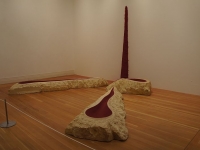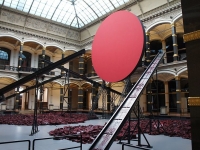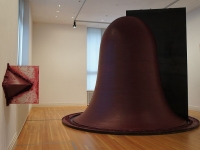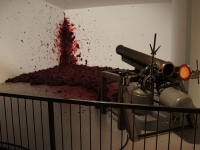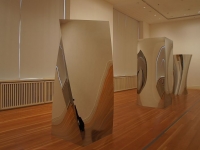Arts
British Artist Anish Kapoor in Berlin from May 18 to November 24, 2013
Anish Kapoor in Berlin, Germany
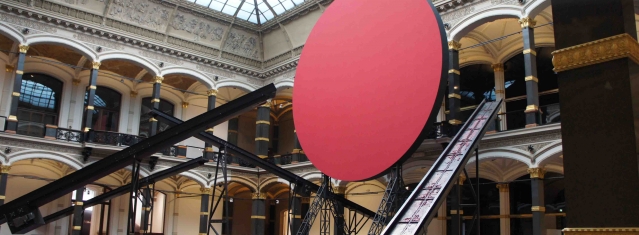
Symphony for a beloved Sun, 2013 (Source: Ilse M. Gibson)
USPA NEWS -
Born in Mumbai in 1954, British artist Anish Kapoor, one of the world´s most prominent contemporary artists displayed his first exhibition in Berlin, Germany. From May 18 to 24 November 2013 his works can be admired on the entire first floor of the “˜Martin-Grobius-Bau´ including the grandiose atrium
70 installed works cover more than 3,000 sq meters.
Kapoor does not fit into any existing category. Each newly created piece redefines another relationship between sculpture, architecture and painting. Characteristic for Kapoors works are his unlimited ability to constantly reinvent himself creating monumental as well as more intimate dimensions in the language of art. Many dualities are revealed in his search for perfection and chaos, using aesthetic effects; while serving his suggestive and inventive pursuit of abstract metaphors. His creations are made of natural and artificial materials. Projects such as the Cloud Gate in Millennium Park, Chicago;
Kapoor does not fit into any existing category. Each newly created piece redefines another relationship between sculpture, architecture and painting. Characteristic for Kapoors works are his unlimited ability to constantly reinvent himself creating monumental as well as more intimate dimensions in the language of art. Many dualities are revealed in his search for perfection and chaos, using aesthetic effects; while serving his suggestive and inventive pursuit of abstract metaphors. His creations are made of natural and artificial materials. Projects such as the Cloud Gate in Millennium Park, Chicago;
Sky Mirror exhibition at the Rockefeller Center; and the not to be overlooked ArcelorMittal Orbit, which is a permanent artwork on display at the Olympic Park in London, have earned him global attention. Art lovers or people interested in art either love him or can´t stand him. There seems to be hardly any in between such as “like“.
An especially designed mixed media sculpture, displayed in the light atrium of the Martin-Grobius-Bau titled “Symphony for the beloved Sun“ was inspired by El Lissitzky, a Russian Constructivist and Joseph Beuys, one of Kapoor´s admired artists. Four conveyor belts obtrude from the floor and rise skywards, carrying red wax.
An especially designed mixed media sculpture, displayed in the light atrium of the Martin-Grobius-Bau titled “Symphony for the beloved Sun“ was inspired by El Lissitzky, a Russian Constructivist and Joseph Beuys, one of Kapoor´s admired artists. Four conveyor belts obtrude from the floor and rise skywards, carrying red wax.
As the wax moves upward, a grinding sound can be heard and when the wax is dumped on the linoleum floor, right in front of the giant red sun, it makes a splashing sound. The softness of the wax turns the work into a continuously changing wax object. Because of the formability of wax, it is the perfect medium for spontaneous ideas for sculptures. “Stack“ (2007) and “Shooting into the Corner“ (2008 ““ 2009) are works like that. “Stack“ is shaped like a big church bell and is sitting on a constantly rotating platform. His work “Shooting into the Corner“ has, at certain, but irregular times of the day, a cannon firing round pellets of wax into a corner, staining the walls in a dark, blood red.
By using color, form and material as his three fundamental elements, he proves his ability to communicate and express himself in an abstract language comprehending the aesthetics of shock and surprise as well as that of nobility and calm.
When Kapoor worked with stone in the late 1980s, he created “Wound“ (1988) where he cut a groove into the inner faces of two stones and filled it with blood red pigment which emphasizes the organic element. The gash continues until it meets the other stone to form a V. The title itself elicits all kinds of images which are in need of an interpretation.
When Kapoor worked with stone in the late 1980s, he created “Wound“ (1988) where he cut a groove into the inner faces of two stones and filled it with blood red pigment which emphasizes the organic element. The gash continues until it meets the other stone to form a V. The title itself elicits all kinds of images which are in need of an interpretation.
Concave and convex mirror structures titled Non-Object Door, (2008), Non-Object Oval Twist, (2013), and Non-Object Square Twist, (2013), might cause confusion, when the viewer sees his reflection distorted in the brightly polished surfaces. In his mirror “Vertigo“ one can experience several perspectives simultaneously in one reflection. The viewer can see himself from a great distance, upside down or in a close-up as through a spy glass. What all his mirror objects have in common is a play with perception. In spite of their minimalistic appearance they are always open and accessible, not self contained or hermetically sealed. Not only are they objects of high interest but for many viewers a contemporary fairy tale landscape.
Liability for this article lies with the author, who also holds the copyright. Editorial content from USPA may be quoted on other websites as long as the quote comprises no more than 5% of the entire text, is marked as such and the source is named (via hyperlink).

